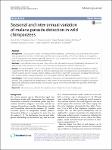Seasonal and inter-annual variation of malaria parasite detection in wild chimpanzees
Wu, Doris F.
Löhrich, Therese
Sachse, Andreas
Mundry, Roger
Wittig, Roman M.
Calvignac-Spencer, Sébastien
Deschner, Tobias
Leendertz, Fabian H.
Background: Cross-sectional surveys of chimpanzee (Pan troglodytes) communities across sub-Saharan Africa show large geographical variation in malaria parasite (Plasmodium spp.) prevalence. The drivers leading to this apparent spatial heterogeneity may also be temporally dynamic but data on prevalence variation over time are missing for wild great apes. This study aims to fill this fundamental gap. Methods: Some 681 faecal samples were collected from 48 individuals of a group of habituated chimpanzees (Taï National Park, Côte d’Ivoire) across four non-consecutive sampling periods between 2005 and 2015. Results: Overall, 89 samples (13%) were PCR-positive for malaria parasite DNA. The proportion of positive samples ranged from 0 to 43% per month and 4 to 27% per sampling period. Generalized Linear Mixed Models detected significant seasonal and inter-annual variation, with seasonal increases during the wet seasons and apparently stochastic inter-annual variation. Younger individuals were also significantly more likely to test positive. Conclusions: These results highlight strong temporal fluctuations of malaria parasite detection rates in wild chimpanzees. They suggest that the identification of other drivers of malaria parasite prevalence will require longitudinal approaches and caution against purely cross-sectional studies, which may oversimplify the dynamics of this host-parasite system.
Dateien zu dieser Publikation
Keine Lizenzangabe

